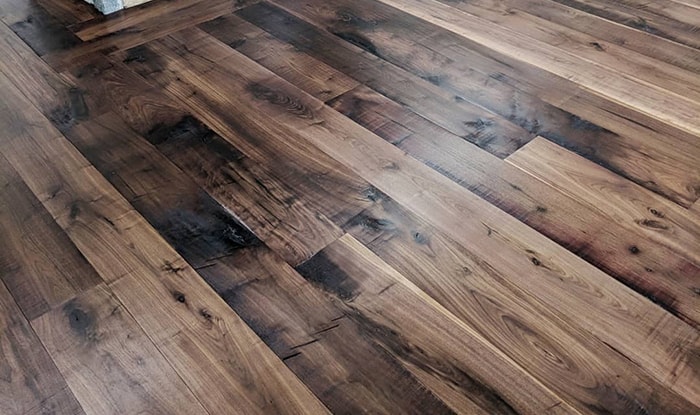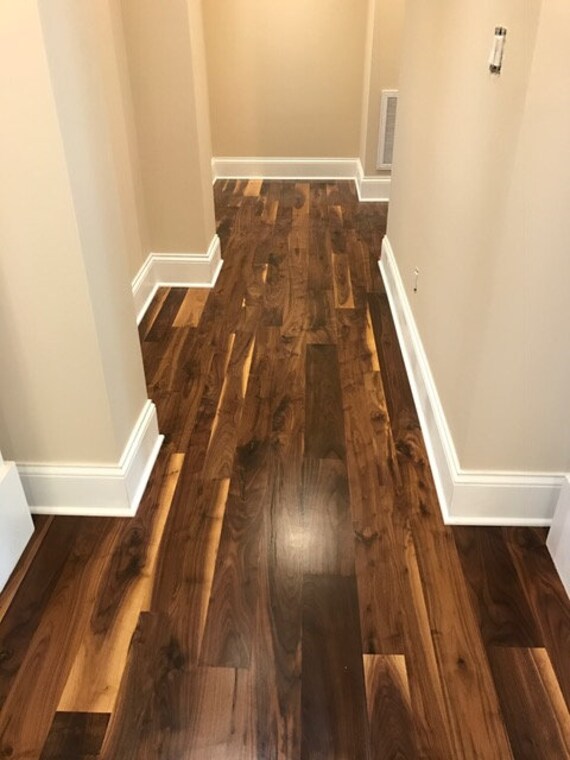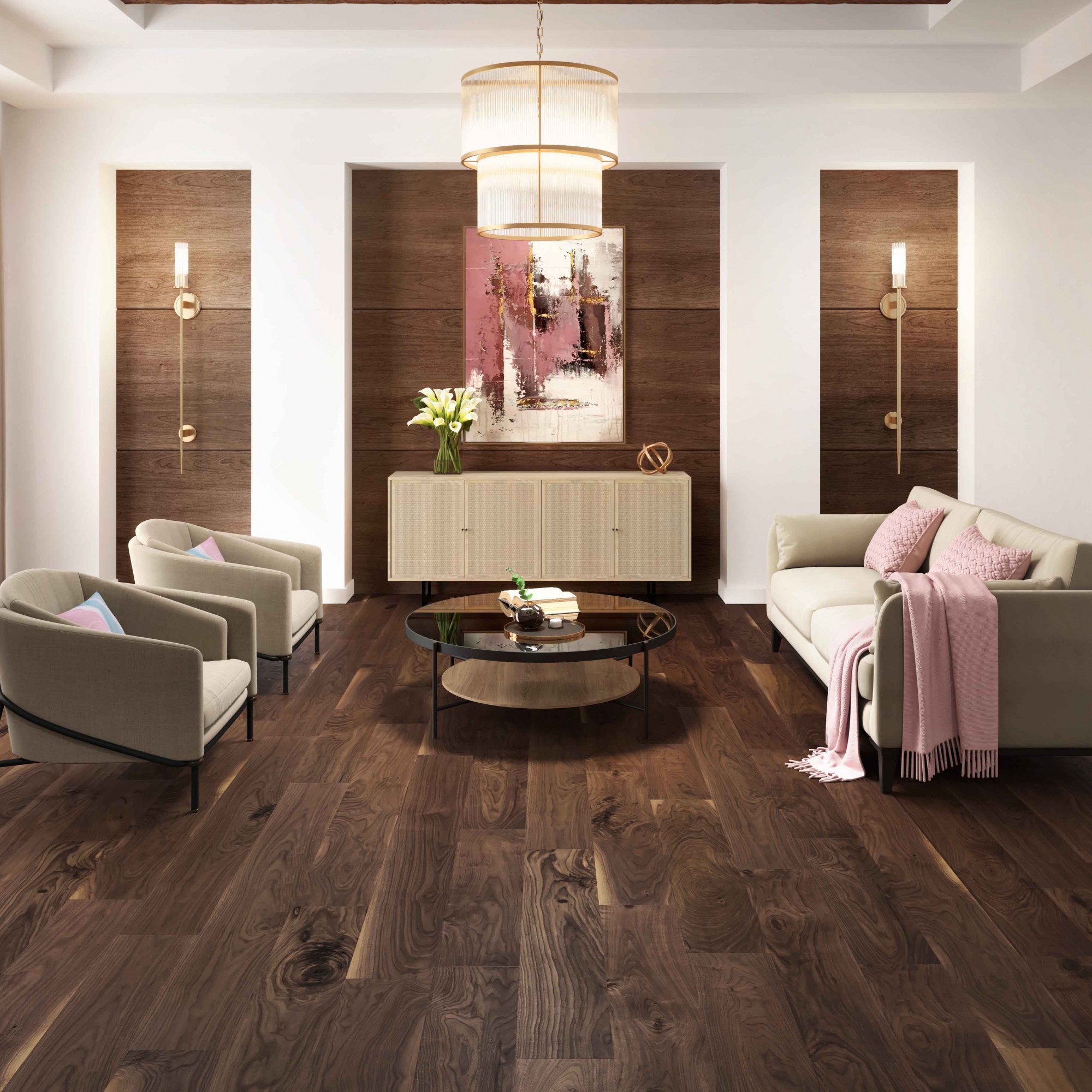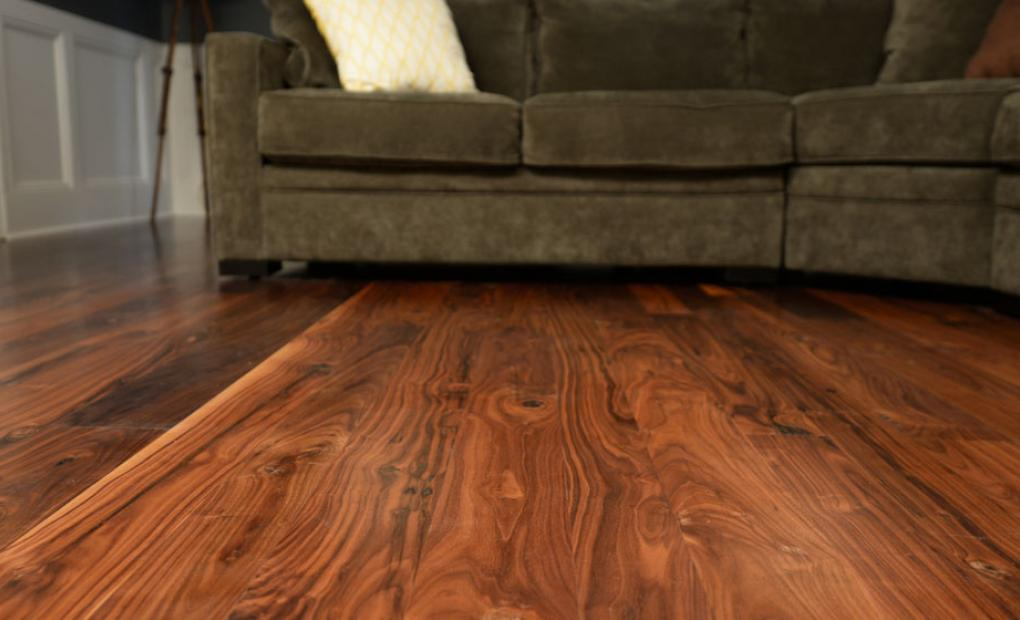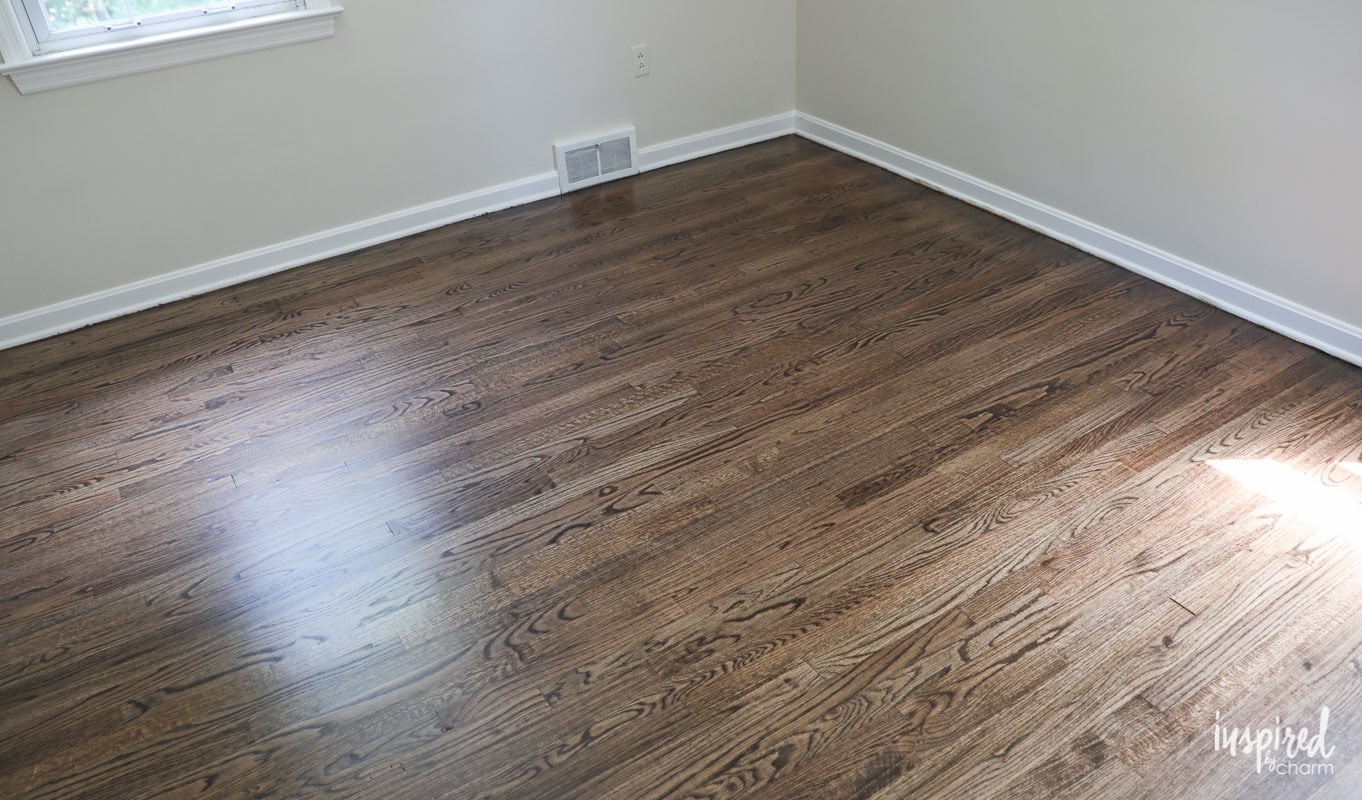Characteristics and Benefits of Black Walnut Hardwood
Black walnut hardwood flooring is prized for its rich, dark color and luxurious appearance. It stands out for several distinct characteristics and benefits that make it a preferred choice for many homeowners.
- Rich, Dark Color: One of the most notable characteristics of black walnut hardwood is its deep, dark color. This wood ranges from a rich chocolate brown to purplish-black tones, often featuring lighter streaks and a straight grain. The dark hue adds a sense of elegance and sophistication to any room.
- Unique Grain Pattern: Black walnut has a unique grain pattern that adds to its visual appeal. The grain can vary from straight to wavy, creating a dynamic look that enhances the floor’s overall beauty. This characteristic makes each black walnut floor unique, offering a distinctive and high-end aesthetic.
- Durability: While black walnut is not the hardest wood on the market, it is still quite durable and suitable for residential use. It ranks at about 1010 on the Janka hardness scale, which means it can withstand daily wear and tear. Its durability makes it a practical choice for living rooms, bedrooms, and even dining areas.
- Stability: Black walnut is relatively stable, meaning it resists shrinking and swelling with changes in humidity and temperature. This stability makes it an excellent option for various climates and reduces the risk of gaps and warping over time. Proper installation and maintenance further enhance its performance.
- Easy to Work With: Another benefit of black walnut hardwood is its workability. This wood is relatively easy to cut, sand, and finish, which simplifies the installation process. Its workability also means it can be customized into various styles and finishes, providing flexibility for homeowners and designers.
- Adds Value to Your Home: Investing in black walnut hardwood flooring can significantly increase the value of your home. Its luxurious appearance and durability are appealing to potential buyers, making it a wise investment for those looking to enhance their property’s market value. The timeless beauty of black walnut ensures it remains a sought-after feature in homes.

Comparing Black Walnut to Other Hardwood Options
When choosing hardwood flooring, it’s essential to compare black walnut with other popular options to understand its advantages and disadvantages.
Oak vs. Black Walnut
Oak is one of the most common hardwood flooring options and is known for its strength and affordability. While oak is harder and more resistant to dents and scratches than black walnut, it lacks the rich, dark color that makes black walnut so distinctive. Oak’s lighter color and prominent grain pattern offer a more traditional look, whereas black walnut provides a more modern and luxurious feel.
Maple vs. Black Walnut
Maple hardwood flooring is known for its light color and subtle grain patterns. It is harder than black walnut, making it more durable in high-traffic areas. However, black walnut’s unique color and grain give it a more sophisticated appearance. Maple’s neutral tone may suit contemporary designs, while black walnut is better for creating a warm, inviting ambiance.
Cherry vs. Black Walnut
Cherry hardwood has a warm, reddish-brown color that darkens with age. It is softer than black walnut, making it more susceptible to dents and scratches. Both woods offer a luxurious look, but black walnut’s deeper, darker tones can create a more dramatic effect. Cherry is ideal for adding warmth to a space, while black walnut offers a sleek, elegant aesthetic.
Hickory vs. Black Walnut
Hickory is one of the hardest domestic hardwoods, known for its distinctive grain patterns and durability. It is an excellent choice for high-traffic areas and households with pets and children. In contrast, black walnut offers a smoother, more refined look. Hickory’s rustic appeal contrasts with the sophisticated elegance of black walnut, catering to different design preferences.
Bamboo vs. Black Walnut
Bamboo is an eco-friendly flooring option known for its sustainability and hardness. While it is not a true hardwood, bamboo is harder than black walnut and offers excellent durability. However, it lacks the unique color and grain patterns of black walnut. Bamboo suits modern, eco-conscious homes, whereas black walnut adds a touch of luxury and traditional elegance.
Exotic Hardwoods vs. Black Walnut
Exotic hardwoods, such as Brazilian cherry and mahogany, offer unique colors and patterns. These woods are often harder and more durable than black walnut. However, they can be more expensive and harder to source. Black walnut’s domestic origin makes it more accessible and sustainable. Exotic hardwoods may provide a striking look, but black walnut’s timeless appeal and availability make it a practical and beautiful choice.
Design and Aesthetic Appeal of Black Walnut Flooring
Black walnut hardwood flooring is renowned for its exceptional design and aesthetic appeal, making it a favored choice for upscale homes and sophisticated interiors.
Luxurious Appearance
The deep, rich tones of black walnut flooring exude luxury and elegance. Its dark color palette, ranging from chocolate brown to almost black, can transform a space into a warm, inviting, and opulent environment. The unique grain patterns further enhance its luxurious appearance, making each plank a work of art.
Versatile Design
Black walnut’s versatile design makes it suitable for various interior styles, from traditional to contemporary. Its dark hues can complement modern minimalist decor, while its classic grain patterns fit seamlessly into traditional and rustic settings. Whether you’re aiming for a sleek, modern look or a cozy, classic feel, black walnut flooring can adapt to your design vision.
Enhances Light and Space
Dark floors like black walnut can make a room feel more intimate and cozy. However, when paired with the right elements, such as light-colored walls and ample natural light, black walnut flooring can create a striking contrast that enhances the sense of space and light in a room. The interplay between dark floors and light surroundings can make a bold and sophisticated statement.
Complements Various Color Schemes
The rich, neutral tones of black walnut flooring complement a wide range of color schemes. Whether you prefer bold, vibrant colors or muted, earthy tones, black walnut provides a versatile backdrop that allows you to experiment with different design elements. It can anchor a room’s aesthetic while allowing for flexibility in decor choices.
Timeless Appeal
The timeless appeal of black walnut flooring ensures that it remains stylish and relevant for years to come. Unlike some trendy flooring options that may fall out of fashion, black walnut’s classic beauty endures, making it a wise investment for homeowners looking for long-lasting style and elegance.
Adds Character and Warmth
The unique grain patterns and natural variations in black walnut wood add character and warmth to any space. Each plank has its own distinct look, contributing to a floor that is rich in texture and visual interest. This natural beauty brings a sense of authenticity and warmth to a home, making it a comfortable and inviting place to live.
Installation Tips for Black Walnut Hardwood Flooring
Proper installation is key to maximizing the beauty and longevity of black walnut hardwood flooring. Here are some essential tips to ensure a successful installation.
Acclimate the Wood
Before installation, it’s crucial to acclimate black walnut hardwood to the room’s temperature and humidity levels. Store the planks in the room where they will be installed for at least 48 to 72 hours. This process helps the wood adjust and minimizes the risk of expansion or contraction after installation.
Prepare the Subfloor
Ensure the subfloor is clean, dry, and level before installing black walnut flooring. Remove any existing flooring, debris, and dust. Address any imperfections, such as cracks or uneven spots, using a leveling compound. A smooth and stable subfloor is essential for a successful installation and long-lasting performance.
Use the Right Tools
Using the right tools is critical for a professional-looking installation. Essential tools include a flooring nailer or stapler, a saw for cutting planks to size, a rubber mallet, spacers, and a tape measure. Additionally, having a moisture meter on hand can help ensure the subfloor and hardwood are at the appropriate moisture levels.
Follow Installation Guidelines
Each manufacturer may have specific installation guidelines for their black walnut hardwood flooring. It’s important to read and follow these instructions carefully to ensure proper installation and maintain any warranties. The guidelines will provide detailed steps on layout, fastening methods, and finishing touches.
Leave Expansion Gaps
Wood expands and contracts with changes in humidity and temperature. To accommodate this natural movement, leave expansion gaps around the perimeter of the room and any fixed objects, such as columns or doorways. These gaps can be covered with baseboards or moldings to create a clean, finished look.
Consider Professional Installation
While DIY installation is possible for those with the necessary skills and tools, professional installation is often recommended for black walnut hardwood flooring. Professional installers have the experience and expertise to handle potential challenges and ensure a flawless finish. Investing in professional installation can save time and prevent costly mistakes.
Maintenance and Care
Maintaining and caring for black walnut hardwood floors is essential to preserving their beauty and longevity. Here are some tips to keep your floors looking their best.
Regular Cleaning
Regular cleaning is vital to prevent dirt and debris from scratching the surface of your black walnut floors. Sweep or vacuum the floors frequently to remove dust and dirt. Use a vacuum with a soft brush attachment to avoid scratching the wood. For deeper cleaning, use a damp mop with a hardwood-specific cleaner.
Protect from Moisture
Black walnut hardwood floors are susceptible to moisture damage. Wipe up spills immediately to prevent water from seeping into the wood and causing warping or staining. Use area rugs or mats in high-moisture areas, such as near sinks or entrances, to protect the floors from water and dirt.
Use Furniture Pads
Place felt pads under the legs of the furniture to prevent scratches and dents. Avoid dragging heavy furniture across the floor, as this can cause significant damage. When moving furniture, lift it instead of dragging it, or use furniture sliders to protect the floor.
Maintain Proper Humidity Levels
Maintaining consistent humidity levels in your home is crucial for the health of your black walnut hardwood floors. Use a humidifier in dry winter months and a dehumidifier during humid summer months to keep indoor humidity levels between 30% and 50%. This helps prevent the wood from expanding, contracting, and developing gaps or cracks.
Refinish When Necessary
Over time, black walnut hardwood floors may show signs of wear, such as scratches, dents, or a dull finish. Refinishing the floors can restore their original beauty and protect the wood. Depending on the level of wear, you may need to sand and refinish the entire floor or spot-treat specific areas. Consult with a professional to determine the best approach for your floors.
Prevent Sun Damage
Exposure to direct sunlight can cause black walnut floors to fade and discolor over time. Use window treatments, such as curtains or blinds, to limit the amount of sunlight that reaches the floors. Additionally, consider using area rugs in sun-exposed areas to protect the wood and preserve its rich color.
Black Walnut – Hickman Woods
Old Growth Black Walnut Hardwood Flooring
Smooth, Black Walnut Natural Vintage Hardwood Flooring, and
Black Walnut Engineered 3-1/4 IN. (Square Edge) by Lauzon Wood Floors
Smooth, Black Walnut Natural Vintage Hardwood Flooring, and
My Refinished Hardwood Floors (Dark Walnut Stain) Refinshing my
Related Posts:
